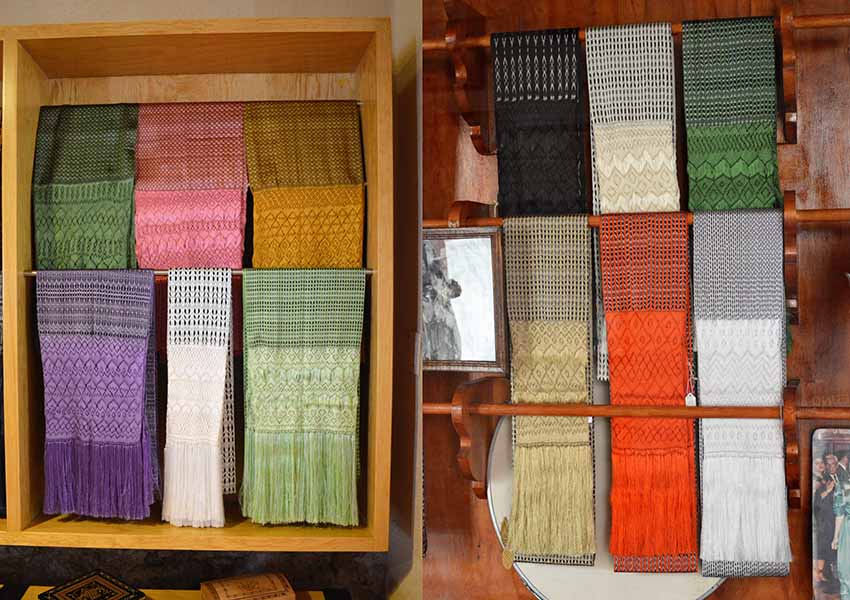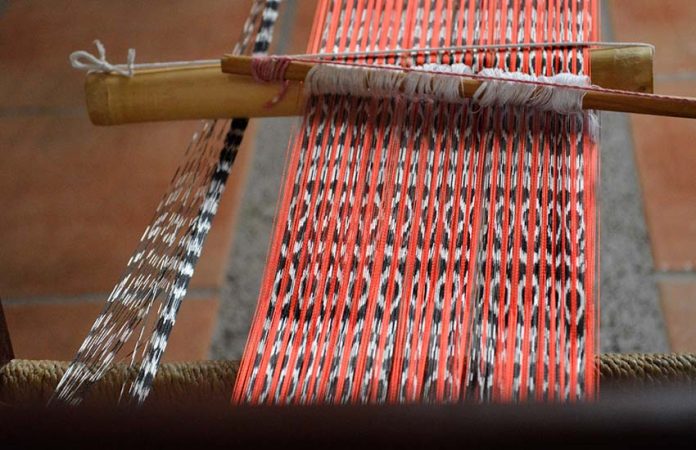Few traditional garments have the nationwide iconic status of the long, rectangular shawl called the rebozo. Not an everyday garment by any means, it comes out of most Mexican women’s closets for patriotic occasions.
Many places in Mexico have traditional regional textile designs, but some of the finest are made not in the former Mesoamerica but just northeast in a small town called Santa María del Río in San Luis Potosí.
The great Mesoamerican empires had little respect for the nomadic people to the north. But after they were conquered, they did accompany their Spanish overlords to help “civilize” them as the Europeans expanded their hold on the continent. This means that Santa María (established in 1589) has Baroque-style churches and traditional dress based on those from farther south.
The town was established with two main neighborhoods, one for the Mesoamericans (primarily Otomi) and one for the local native Guachichils who, pre-contact, occupied the most extensive territory of all the indigenous Chichimeca nations tribes in pre-Columbian central Mexico. Various handcrafts were introduced, including the weaving of the rebozo.
The Otomis brought with them the ikat technique — where threads are bunched, tied off and dyed before weaving — which the Spanish originally brought to Mexico from Asia.

Otomi garments were made with cotton, but Santa María’s twist on the garment would be the use of silk. The Spanish had introduced silkworms to Mexico as the silk trade was still quite lucrative at the time.
Silk threads are harder to work with since they are thinner and break easily, but the resulting garment is extremely fine. The best examples of these rebozos can literally be pulled through a wedding ring, a method used to prove that the garment was truly made of 100% silk. These items were favored by wealthy women of San Luis Potosi city and some other areas during the colonial period.
Today, such silk rebozos are still made here, but they are pricey, starting at 2,500 pesos for a small, simple one. After that, the sky’s almost the limit.
As most customers can’t or won’t pay that much, most weavers are also adept at using acrylics and other “false silks.” They are what you see all over town in Santa María hanging in doorways. But they can be works of art as well.
Artisans in the town make both solid color and patterned rebozos. The former are often called chalinas and come in a wide variety of colors. Those with patterns are still made with the ikat method. The pattern is not seen until the dyed threads are woven.
There are seven traditional designs, and all are still available today, generally referred to by the numbers one to seven. The distinctions between the numbers relate to the designs’ pattern and color combination. For example, No. 1, known as the bolita, consists of small black dots and lines on a white background and is the most representative of the area.
Santa María’s rebozos are similar to, and may have their origins from, ones in Tenancingo, Mexico state, which happens to be an Otomi area.
The production of silk in San Luis Potosí died out long ago. True silk threads are now imported from China. Natural dyes, with only a few exceptions, are also gone, mostly because they are impossible to use with synthetic threads, which won’t pick up the dye.
Tying off the edges is an art form in itself. It is usually done by specialized artisans who work the edges with their fingers. They are not knotted simply to keep the piece from unraveling. Complicated patterns have been established with names such as “the duck’s tail,” “the pine arch” and the daring “make me if you can.”
The best and most traditional rebozos are still made on Mesoamerican backstrap looms. But cheaper versions now use foot pedal looms, and a few are made with more modern devices. However, most consider those made on the backstrap loom to be of superior quality because the ikat technique requires very precise thread placement to get the pattern exact. Each rebozo takes one or two months to make, but time is of the essence. A piece left on the loom too long stretches and becomes distorted.

The best way to see and buy fine silk or acrylic rebozos is to visit Santa María. Those displayed outside are entirely of acrylic and also tend to be the cheapest. Some are even knockoffs from other places.
There are two reliable places to buy good and great quality rebozos. The first is the Escuela de Rebozo (Rebozo School), established in 1953 by the state to revive the craft. Just off the main plaza, it has a store with a small selection.
The Taller Escuela de Rebocería (The Teaching Workshop of Rebozo Making) on Ocampo street — often referred to as the Cooperativa — dates back to the 1980s and represents a number of artisans in the area. It has a larger selection.
Most rebozos today are shorter than those made in the past, primarily because they now are almost exclusively used as fashion accessories rather than as a modesty garment or for carrying babies and goods.
Although the craft is in a far better position than before, its survival is not assured. Even when made of silk, it is hard to convince many buyers that the thousands of pesos they charge is worth paying for what is basically a very beautiful rectangular piece of cloth. But the cost comes from the time needed to make that rectangle and fringe by hand.
And when all is said and done, that price translates only to a subsistence income for artisans. So it’s understandable that the temptation to make more money more easily in the capital draws the younger generation away.
Leigh Thelmadatter arrived in Mexico 18 years ago and fell in love with the land and the culture in particular its handcrafts and art. She is the author of Mexican Cartonería: Paper, Paste and Fiesta (Schiffer 2019). Her culture column appears regularly on Mexico News Daily.
